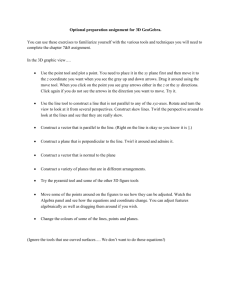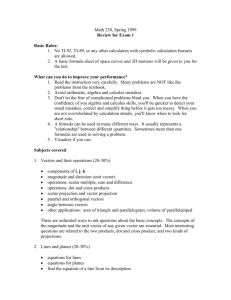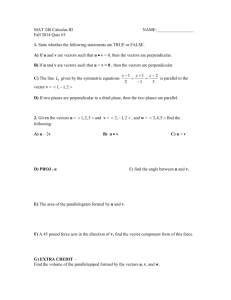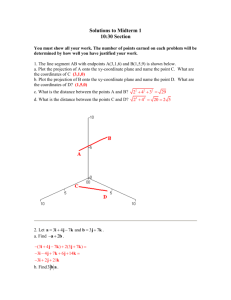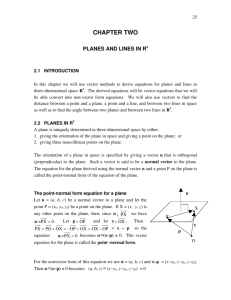4: Lines and Planes
advertisement
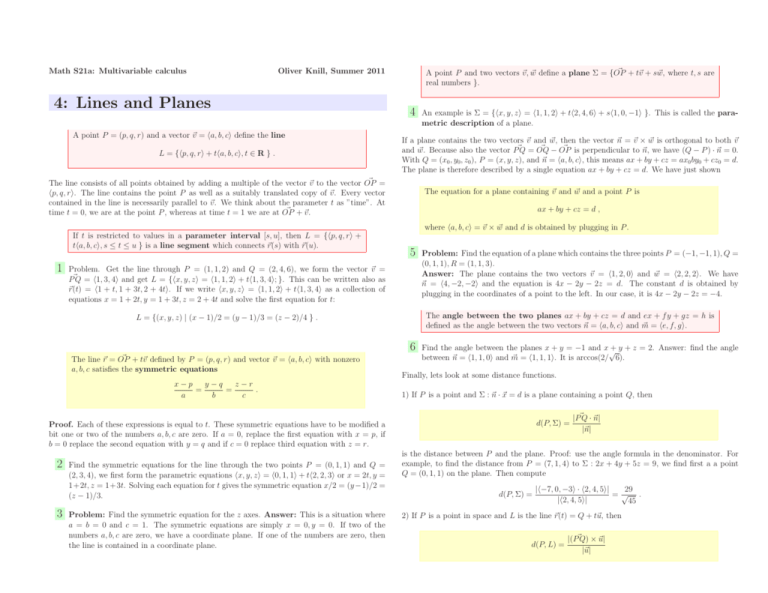
Math S21a: Multivariable calculus
~ + t~v + sw,
A point P and two vectors ~v , w
~ define a plane Σ = {OP
~ where t, s are
real numbers }.
Oliver Knill, Summer 2011
4: Lines and Planes
A point P = (p, q, r) and a vector ~v = ha, b, ci define the line
L = {hp, q, ri + tha, b, ci, t ∈ R } .
4
If a plane contains the two vectors ~v and w,
~ then the vector ~n = ~v × w
~ is orthogonal to both ~v
~ − OP
~ is perpendicular to ~n, we have (Q − P ) · ~n = 0.
and w.
~ Because also the vector P~Q = OQ
With Q = (x0 , y0 , z0 ), P = (x, y, z), and ~n = ha, b, ci, this means ax + by + cz = ax0 by0 + cz0 = d.
The plane is therefore described by a single equation ax + by + cz = d. We have just shown
~ =
The line consists of all points obtained by adding a multiple of the vector ~v to the vector OP
hp, q, ri. The line contains the point P as well as a suitably translated copy of ~v . Every vector
contained in the line is necessarily parallel to ~v . We think about the parameter t as ”time”. At
~ + ~v.
time t = 0, we are at the point P , whereas at time t = 1 we are at OP
If t is restricted to values in a parameter interval [s, u], then L = {hp, q, ri +
tha, b, ci, s ≤ t ≤ u } is a line segment which connects ~r(s) with ~r(u).
1
The equation for a plane containing ~v and w
~ and a point P is
ax + by + cz = d ,
where ha, b, ci = ~v × w
~ and d is obtained by plugging in P .
5
Problem. Get the line through P = (1, 1, 2) and Q = (2, 4, 6), we form the vector ~v =
P~Q = h1, 3, 4i and get L = {hx, y, zi = h1, 1, 2i + th1, 3, 4i; }. This can be written also as
~r(t) = h1 + t, 1 + 3t, 2 + 4ti. If we write hx, y, zi = h1, 1, 2i + th1, 3, 4i as a collection of
equations x = 1 + 2t, y = 1 + 3t, z = 2 + 4t and solve the first equation for t:
6
y−q
z−r
x−p
=
=
.
a
b
c
Problem: Find the equation of a plane which contains the three points P = (−1, −1, 1), Q =
(0, 1, 1), R = (1, 1, 3).
Answer: The plane contains the two vectors ~v = h1, 2, 0i and w
~ = h2, 2, 2i. We have
~n = h4, −2, −2i and the equation is 4x − 2y − 2z = d. The constant d is obtained by
plugging in the coordinates of a point to the left. In our case, it is 4x − 2y − 2z = −4.
The angle between the two planes ax + by + cz = d and ex + f y + gz = h is
defined as the angle between the two vectors ~n = ha, b, ci and m
~ = he, f, gi.
L = {(x, y, z) | (x − 1)/2 = (y − 1)/3 = (z − 2)/4 } .
~ + t~v defined by P = (p, q, r) and vector ~v = ha, b, ci with nonzero
The line ~r = OP
a, b, c satisfies the symmetric equations
An example is Σ = {hx, y, zi = h1, 1, 2i + th2, 4, 6i + sh1, 0, −1i }. This is called the parametric description of a plane.
Find the angle between the planes x + y = −1 and x √
+ y + z = 2. Answer: find the angle
between ~n = h1, 1, 0i and m
~ = h1, 1, 1i. It is arccos(2/ 6).
Finally, lets look at some distance functions.
1) If P is a point and Σ : ~n · ~x = d is a plane containing a point Q, then
d(P, Σ) =
Proof. Each of these expressions is equal to t. These symmetric equations have to be modified a
bit one or two of the numbers a, b, c are zero. If a = 0, replace the first equation with x = p, if
b = 0 replace the second equation with y = q and if c = 0 replace third equation with z = r.
2
3
Find the symmetric equations for the line through the two points P = (0, 1, 1) and Q =
(2, 3, 4), we first form the parametric equations hx, y, zi = h0, 1, 1i + th2, 2, 3i or x = 2t, y =
1+2t, z = 1+3t. Solving each equation for t gives the symmetric equation x/2 = (y −1)/2 =
(z − 1)/3.
Problem: Find the symmetric equation for the z axes. Answer: This is a situation where
a = b = 0 and c = 1. The symmetric equations are simply x = 0, y = 0. If two of the
numbers a, b, c are zero, we have a coordinate plane. If one of the numbers are zero, then
the line is contained in a coordinate plane.
|P~Q · ~n|
|~n|
is the distance between P and the plane. Proof: use the angle formula in the denominator. For
example, to find the distance from P = (7, 1, 4) to Σ : 2x + 4y + 5z = 9, we find first a a point
Q = (0, 1, 1) on the plane. Then compute
d(P, Σ) =
29
|h−7, 0, −3i · h2, 4, 5i|
=√ .
|h2, 4, 5i|
45
2) If P is a point in space and L is the line ~r(t) = Q + t~u, then
d(P, L) =
|(P~Q) × ~u|
|~u|
is the distance between P and the line L. Proof: the area divided by base length is height
of parallelogram. For example, to compute the distance from P = (2, 3, 1) to the line ~r(t) =
(1, 1, 2) + t(5, 0, 1), compute
√
|h−1, −2, 1i × h5, 0, 1i| |h−2, 6, 10i|
140
√
=
= √
.
d(P, L) =
h5, 0, 1i
26
26
Homework
1
Find the parametric and symmetric equation for the line which passes through the points
P = (1, 2, 3) and Q = (3, 4, 5).
3) If L is the line ~r(t) = Q + t~u and M is the line ~s(t) = P + t~v , then
d(L, M) =
|(P~Q) · (~u × ~v )|
|~u × ~v |
is the distance between the two lines L and M. Proof: the distance is the length of the vector
projection of P~Q onto ~u × ~v which is normal to both lines. For example, to compute the distance
between ~r(t) = (2, 1, 4) + t(−1, 1, 0) and M is the line ~s(t) = (−1, 0, 2) + t(5, 1, 2) form the cross
product of h−1, 1, 0i and h5, 1, 2i is h2, 2, −6i. The distance between these two lines is
d(L, M) =
4
|(3, 1, 2) · (2, 2, −6)|
=√ .
|h2, 2, −6i|
44
2
3
Find a parametric equation for the line through the point P = (3, 1, 2) that is perpendicular
to the line L : x = 1 + t, y = 1 − t, z = 2t and intersects this line in a point Q.
4
Given three spheres of radius 1 centered at A = (1, 2, 0), B = (4, 5, 0), C = (1, 3, 2). Find a
plane ax + by + cz = d which touches all of three spheres from the same side. Hint. There
4) To get the distance between two planes ~n · ~x = d and ~n · ~x = e, then their distance is
d(Σ, Π) =
|e − d|
|~n|
A regular tetrahedron
has vertices at
points P1 =
√
√ the √
(0, 0, 3),P
√ 2 =√(0, 8, −1), P3 = (− 6, − 2, −1) and
P4 = ( 6, − 2, −1). Find the distance between two
edges which do not intersect.
are two such planes. You want to consider the plane through the three points A, B, C first. You
only need to find one of the two possible planes touching all the spheres on the same side.
Non-parallel planes have distance 0. Proof: use the distance formula between point and plane.
For example, 5x + 4y + 3z = 8 and 10x + 8y + 6z = 2 have the distance
7
|8 − 1|
=√ .
|h5, 4, 3i|
50
To finish this chapter, lets mention a distance problem
which has a great deal of application and motivates the
material of the upcoming week: The global positioning system GPS uses the fact that a receiver can get
the difference of distances to two satellites. Each GPS
satellite sends periodically signals which are triggered
by an atomic clock. While the distance to each satellite
is not known, the difference from the distances to two
satellites can be determined from the time delay of the
two signals. This clever trick has the consequence that
the receiver does not need to contain an atomic clock itself. To understand this better, we need to know about
functions of three variables and surfaces.
5
a) Find the distance between the point P = (3, 3, 4) and the line x = y = z.
b) Parametrize the line ~r(t) = hx(t), y(t), z(t)i in a) and find the minimum of the function
f (t) = d(P, ~r(t))2 . Verify that the the minimal value agrees with a).

